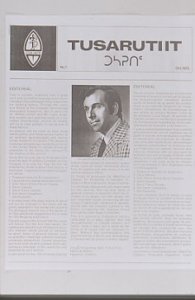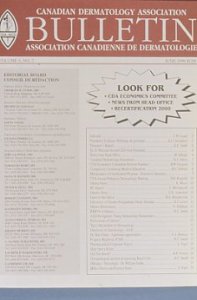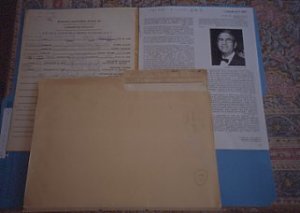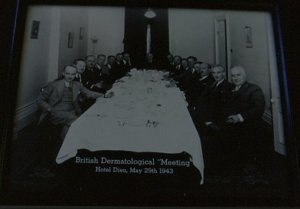Robert Jackson, MD, FRCPC
Archivist, Canadian Dermatology Association
Emeritus Professor of Medicine (Dermatology)
University of Ottawa
#508-1081 Carling Avenue, Ottawa, ON K1Y 4G2
Previously published in Canadian Bulletin of Medical History, 2000 ; 17: 257-267
ABSTRACT
This article describes some details of the archival material of the Canadian Dermatology Association (CDA). Covering its 75 years of existence, these archives consist of seven items :
(1) 38 volumes of bound archives
(2) triannual issues since 1975 of the CDA Journal/Bulletin (a socio-political historical newsletter)
(3) members’ files containing extensive biographical material
(4) a collection of 150 books and other pamphlets
(5) since 1995, the scientific peer-reviewed official journal of the CDA (Journal of Cutaneous Medicine and Surgery)
(6) a sporadic collection of photographs, meeting sound tapes and protocols of patient presentations at the annual meetings
(7) a miscellany of historical articles on Canadian dermatologists and dermatology published in other medical journals and two books published separately.
The Canadian Dermatology Association is a medical society of Canadian dermatologists. Once a year at its annual meeting the CDA pulls together its far-flung – and often isolated – practitioners for formal and informal discussions. These cover scientific, educational, social and business matters. It is not a trade organization, because dermatological health matters relating to the business of practice are controlled by the provinces and territories.
We have about 400 members, mainly in Canada. The CDA was founded in 1925 as the Canadian branch of the British Association of Dermatology; in 1947 we left the parent British Association to become the Canadian Dermatological Association. So the year 2000 will be the diamond jubilee meeting in Montreal. Several articles on the history of the Association have been published1,2,3,4.
The archival material can be described under seven headings.
First are the 38 bound official archives from 1925 to 1992.

Bound archives of CDA 1925-1990.
While the size of each volume varies, each is about 500 pages long.
I have reviewed the volume 1964 to 1967 to illustrate some of the usual and unusual contents. As most of the activity of the CDA is centered about the annual meeting, so the main portion of these bound archives concerns itself with the annual meeting.
The 1964 meeting was held in Vancouver from June 23 – June 27. The full Minutes include the programme, record 46 attended, gave the financial report and reports of committees. That meeting had a special session on teaching dermatology to medical students in Canada. As well, the first clinico-histopathological session was held. There was a panel entitled Dermatology and the Economic Climate with speakers from British Columbia, Alberta, Saskatchewan and Ontario. (This was two years after the introduction of universal medicare in Saskatchewan.) Abstracts of all papers presented are included.
The 1965 meeting was held in Montreal from June 15 – June 18. The Minutes record the programme, reveal 69 attended, give a financial report and report of committees. There were special presentations on psoriasis, psoralens, topical steroids, and DMSO. There was a minor fuss after the meeting because a non-member was allowed to give a paper and a drug-sponsored guest from Argentina did not reveal his drug connections. Both, unfortunately, made poor presentations.
The 1966 Jasper meeting was held from June 28 – July 2. According to the Minutes, 39 attended, 11 new members were elected and there was the usual financial and committee reports. A « What’s New » section was started, the histopathological conference was re-introduced and there is a complete listing of the « I Have a Case » presentations. Two items of note: Dr. Goodman introduced a suggested dermatology fee schedule for Canadian dermatologists; Dr. Ereaux was made a ceremonial Indian Chief of the Sarcee Indian tribe.
The 1967 meeting was held at Lac Beauport from June 30 – July 4. 53 attended, 19 new members were elected and there were the usual financial and committee reports. The patient presentations were at the Hotel Dieu Hospital in Quebec City. Because 1967 was the year that Expo was in Montreal, there was considerable difficulty in arranging this meeting.
Other items, not primarily meeting orientated, found in this 1964 to 1967 volume include the following. There were some details on applications for new and honorary memberships to the CDA, obituaries of permanent members (Gaumond, Williamson, Ereaux) and lists of members dated 1965 and 1967. The CDA’s relation with other scientific bodies – the Royal College of Physicians and Surgeons of Canada, the Canadian Medical Association and the International Congress of Dermatology which was held in Munich in 1967 – were documented. Other items of some interest to the CDA recorded were the ordering and distribution of CDA pins for past presidents, a bill for $260.00 for the Canadian reception at the American Academy of Dermatology meeting (this was considered excessive!), a request for names of CDA members for their consideration for the newly-minted Centennial Medal, two news items: Dr. Maddin was elected President of the Canadian Amateur Swimming Association and Dr. Leclerc played his 20,000th set in tennis, a report by Dr. Mitchell on the proportional distribution of skin disease in 12,578 patients, and plans for a resident’s forum in vancouver in 1968.
A recurring theme was the role of the drug industry in the activities of the CDA. Questions such as should drug companies be allowed to sponsor dinners and receptions, should they be allowed to have displays at CDA meetings, and should CDA member dermatologists who worked full time for drug companies be treated differently.
I have reviewed the bound volume for 1964 to 1967. Prior to this and certainly after 1947 the volumes covering up to 1964 are really quite complete, especially as regards the annual meeting. Prior to 1947, the material is more sketchy but surprisingly complete with records of most meetings from 1926. The CDA Bulletin was founded in 1975 and some of the material which used to go into these annual bound volumes is now included in the Bulletin.
Second are the triannual issues, starting in 1975, of the CDA Bulletin (called the CDA Journal up until 1994).

Canadian Dermatological Association Journal, October 1975. First issue, front cover.

Canadian Dermatology Association Bulletin, June 1999 issue. Front cover.
This socio-political-historical journal nicely fills in the background of some of the items and persons reported in the bound archives. But it has done more than that. Regional problems across Canada are discussed in detail. Interim CDA business can be reported to the members in a more timely fashion. Mini-historical articles concerning dermatology and Canadian dermatologists are a regular feature. All obituaries are now published in this journal.
I will review the contents of the first edition and a recent one. The opening paragraph of the first edition read as follows:
« Few in number, scattered over a great land, and divided by language and culture, Canadian Dermatologists have a real need for unifying factors. Through the vision and efforts of the Canadian Dermatology Association Executive, and in particular Dr. William Linton and Mr. Louis Vogel, this humble and opening issue of a Canadian Dermatology Journal or Digest, will try at least partially to act as one of these factors. »
In this four-page issue there is a report from the CDA’s secretary-treasurer and a notice on the upcoming CDA meeting in Dublin in 1976. Regional news included a meeting of the Montreal Dermatological Society to be held in Kingston, news from British Colubmia and a note on Maritime dermatology from Halifax.
The June 1999 sixteen-page issue is considerably more elaborate but in many ways confirms and endorses and fulfils the objectives listed in the first issue in the editorial by Dr. Rosenthal.

File on the late Dr. A.M. Davidson (1885-1972) of Winnipeg showing completed application form, Did You Know historical vignette with photograph and his collected papers.
Six articles are on CDA affairs, six on regional dermatological news, two on Royal College business, and two on matters of the American Academy of Dermatology which might affect Canadian dermatologists. There is a report that two Canadians are among the top 25 cited authors in dermatology in the world. There are two articles on retired dermatologists and an obituary. There is a short note on office moves and practice starts. This issue is typical of many.
Third are the members’ files containing extensive biographical material such as an original application form, a CV, a photograph, sometimes a file of reprints and often an obituary. These exist for the last 50 years.
Some member information (including obituaries) before that is present in bound archives; much more is in the list of papers and books discussed in item seven, especially in the Vignettes book by Dr. Forsey (Table 1 – Ref. 10). There are three sets of members’ files – one is of those who have died, one is of living (mainly Senior) members on whom there is an almost complete file, and one is of members up to the early 1990s.
Fourth is a collection of approximately 150 books and pamphlets belonging to the CDA and kept at the Women’s College Hospital in Toronto. This CDA Historical Collection is of material mainly from the early and mid 1900s, seven were published before 1900. There is a copy of Daniel Turner’s 1714 De Morbis Cutaneis. There are eight reprints of bibliography of secondary services on the history of dermatology pbulished originally in the International Journal of Dermatology and the American Archives of Dermatology. Attempts are being made to enlarge this collection. Hopefully arrangements can be made with Revenue Canada so that a tax receipt can be given to those willing to donate their books to this collection.
The fifth portion of the archives is the official publication of the CDA called the Journal of Cutaneous Medicine and Surgery. It started in 1995 and it is listed in Index Medicus. In addition to the usual scientific articles on dermatological subjects, in the Point-Counter Point Section there are often policy discussions on, for example, the pros and cons of cosmetic dermatology. There is a section called Classics in Dermatology. This section contains review articles of significant and original dermatological publications5.
The sixth portion is a miscellaneous collection of black and white and coloured prints and 35mm transparencies. Some meetings have a very complete collection, but some have not been identified and labelled. The more complete ones are listed in Reference 6.

Photo of meeting of the Canadian Branch of the British Association of Dermatology held on May 29, 1943 at the Hotel Dieu Hospital in Montreal.
There are complete sound tapes of two meetings7. At the CDA annual meeting for many years (from 1926 to 1967) there was a presentation of live patients. Protocols exist of most of them 8.

Photo of patient protocols at Vancouver in 1964 and Halifax in 1958.
In these protocols are descriptions of rare and unusual diseases and conditions difficult to treat. A survey of these protocols will illustrate a snapshot picture of difficult dermatological disease at a specific time. Finally, there is a variety of poster displays, and an account day book from 1968 to 1976.
The seventh component of the CDA Archival material are historical articles in other medical journals and two published books. These are listed in Table 1. The most prolific author is Dr. R. Roy Forsey of Montreal. He was the CDA historian for many years and has been the main driving force behind the collection of archival material, along with the late Drs. D.E.H. Cleveland of Vancouver and Arthur R. Birt of Winnipeg. Presently, Dr. Forsey is one of my committee members and is a great source of information. The Vignettes booklet (Table 1 – Ref. 10) is a collection mainly of Dr. Forsey’s articles from the CDA Bulletin from 1975 – 1990.
This archival material has moved around Canada for storage from the homes and offices of several CDA historian-archivists to two university libraries. To me it is a miracle that none of the material was lost. Thankfully, in the last three years the CDA has had a permanent home office in Ottawa. While most of the material is in the Ottawa office, the book collection is still in the Dermatology Division of the Women’s College Hospital in Toronto.
References
1. Cleveland DEH, Forsey RR.
The Canadian Dermatological Association : The First 25 Years.
Canad Med Assn J 1956;75:863-865.
2. Forsey RR.
History of the Canadian Dermatological Association : Genesis and Kings.
Arch Dermatol 1965;91:486-492.
3. Birt AR.
The Canadian Dermatological Association : First Fifty Years.
Int J Dermat 1977;16:289-295.
4. Forsey RR.
The Canadian Dermatological Association in Medical Speciality Societies of Canada.
Edited by Morley TP. Erin, Ontario. Boston Mills Press. 1991.
5. Jackson R.
How Do Physicians React to New Knowledge : The Experience of Jonathan Hutchinson 1828-1913 with Comments on its Relevance Today.
Jour Cut Med & Surg 1998;3(No.1):54-56.
– The Natural History of Strawberry Naevi.
Ibid 1998;2(No.3):187-189.
– Geographic Pathology of Skin Cancer and Fred Urbach.
Ibid 1999;3(No.3):120-122.
– Duhring on Dermatitis Herpetiformis.
Ibid 1999;3(No.3):336-338.
– John Updike on Psoriasis : At War with my Skin, From the Journal of a Leper.
Ibid 2000;4(No.2):113-115.
6. This listing is for separate items, many others are in the bound archives, particularly before 1950. Many, but not all, are identified by date and content. Unless otherwise noted, photos are of the annual meeting.
- Photographs : black and white
1. 4×5 photographs of all 61 presidents from 1926 (some were president more than once). Only Dr. McGovern is missing but I have other group photographs of him from which I can get a copy.
2. CDA group photos at annual meeting:
Montreal 1943
Winnipeg 1947
Winnipeg 1949
Quebec City 1950 two, one extra of annual dinner
Montreal 1951
Montreal 1952
Montreal 1965
3. Miscellany:
Vancouver 1964 many black and white photographs
Jasper 1966 photos of historical exhibits by Drs. Cleveland and Forsey - Photographs : colour prints
Quebec City 1984 many colour prints
Vancouver 1990 many colour prints - Photographs : 35mm transparencies
Halifax 1958 a few
Banff 1960 a few
Quebec City 1967 many
Halifax 1981 many
Edmonton 1982 many
Quebec City 1984 many – three large binders - Three small boxes of unsorted slides from various sources.
- Other slides mostly of CDA office in Royal College building.
7. Sound Tapes
Annual meetings :
Edmonton 1982 full set
St. John’s 1997 full set
Dr. Forsey’s interview with Drs. Kalz and Schopflocher in 1989.
8. Protocols of case histories of live patients presented at the annual meetings.
This is a list of the separate ones. Some others, especially before 1950, are included in the bound volumes. These earlier ones are less detailed.
June 13, 1945 Montreal 38 patients
June 9, 1950 Quebec City 39 patients
June 11, 1952 Montreal 28 patients
June 16, 1954 Vancouver 23 patients
June 23, 1955 Toronto 27 patients
June 14, 1956 Quebec 25 patients
May 16, 1957 London, Ontario 32 patients
July 19, 1958 Halifax 28 patients
June 17, 1961 Ottawa 26 patients
June 21, 1962 Winnipeg 23 patients
June 15, 1963 Toronto 22 patients
June 24, 1964 Vancouver 19 patients
July 3, 1967 Quebec City 26 patients
TABLE 1. LIST OF PAPERS AND BOOKS ON HISTORY OF CANADIAN DERMATOLOGY (exclusive of those in References)
1. Howell WB.
Francis John Shepherd
His Life and Times. Toronto. Dent & Sons. 1934.
2. Forsey RR.
James Elliot Graham : Canada’s First Dermatologist.
Arch Dermatol 1969;99:226-231.
3. Forsey RR.
Barney David Usher 1899-1978.
J Cut Path 1979;6:144-146.
4. Bendl BJ.
Donald Ernest Howell Cleveland, portrait of a compleat physician.
BC Medical J 1982;24:508.
5. Gray C.
Profile, Arthur Birt.
Canad Med Assn J 1983;129:1299.
6. Roland CG.
Canada’s First Dermatologist.
Ontario Medicine. June 15, 1987, p.25.
7. Simpkins MA.
Profiles in Dermatology: Dr. Robert Jackson.
Contemporary Dermatology. 1987. June/July, pp 40-42.
8. Hildebrandt G.
Profiles in Dermatology: Dr. Norman Wrong.
Contemporary Dermatology. 1988. June/July, pp 36, 38, 39.
9. Jackson R, Forsey RR.
Acne Therapy: 1934-1949.
Int J Derm 1988;27:661-663.
10. Forsey RR.
Vignettes of Canadian Dermatology. Montreal.
Trans Canada Derm Inc. 1990.
(A collection of 25 « Did You Know » articles from the CDA Bulletin from its founding in 1975 until 1990 plus other miscellaneous articles. These are a great source of historical material to augment the incomplete CVs of early members.)
11. Forsey RR.
The Crazy Canucks.
Int J Derm 1990;29:61-71.
12. Forsey RR.
The Canadian Dermatological Association in Medical Speciality Societies of Canada.
Edited by Morley TP. Erin, Ontario. Boston Mills Press. 1991.
13. Jackson R.
Have You Read ?
Interesting Early Publications of Canadian Dermatologists.
CDA Bulletin Lichen simplex chronicus – Cleveland & Danto 1994;8(No.3):28
Ibid Mepacrine lichen planus – Peterkin & Hair 1995;9(No.1):29
Ibid Lichen sclerosus et atrophicus – Raymond & Girard 1995;9(No.2):32
Ibid Bacteriology of kerion – Birt 1995;9(No.3):44.
14. Swiggum S.
History of Canadian Women Dermatologists.
Jour Cut Med & Surg 1998;3 Meeting Guide:20-21. Abstract.
15. Forsey RR. « Did You Know »
CDA Journal Ereaux LP 1991;5(No.2):28;
Ibid Campbell GG 1991;5:(No.3):47;
Ibid Burgess JF 1992;6(No.1):30;
Ibid Donahue WL 1992;6(No.2):27;
Ibid Clouston HR 1992;6(No.3):44;
Ibid Hair HC 1993;7:(No.2):23;
Ibid George S. Williamson Fund 1993;2(No.2):24;
Ibid Mitchell JC 1993;7:(No.3):31;
Ibid Kanee B 1993;7:(No.1):32;
Ibid Schachter RK 1993;7(No.2):25;
CDA Bulletin Scoffield ME 1994;8(No.1):37;
Ibid Simone A 1994;8(No.2):30;
Ibid Mitchell DS 1994;8(No.3):26;
Ibid Sibbald RG 1995;9(No.1):28;
Ibid Wrong NM and Syphilology 1995;9(No.2):24;
Ibid Forsey RRP 1995;9(No.3):42;
Ibid Stratton TB 1998;5(No.1):11;
Ibid Donsky HJ 1998;5(No.2):12;
Ibid Enta T 1998;5(No.3):14;
Ibid Grant JD 1999;6(No.2):14;
Ibid The Trows, Sr and Jr 1999;6(No.1):12.
16. Jackson R, Forsey RR.
There Were Giants in the Earth in Those Days. Dermatologists in British Columbia Before 1950.
CDA Bulletin 1999;6(No.3):15-17.
17. Norton, Larry.
History of the Atlantic Dermatological Conference.
Jour Cut Med & Surg 1999;3(No.3):123-126.
